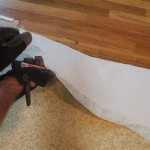Laminate flooring transition strips are often used to connect two different types of flooring, such as carpet and laminate. These strips are available in a variety of materials, colours, and styles, and provide a seamless transition between two different flooring types. In this article, we’ll explore the different types of laminate flooring transition strips, as well as their advantages, installation tips, and more.
Types of Laminate Flooring Transition Strips
There are several different types of laminate flooring transition strips, including:
- T-shaped strips: These are the most common type of transition strips. They are usually made of either plastic or metal and are designed to fit together at the edges. They are also available in a variety of colours and finishes to match your flooring.
- L-shaped strips: These strips are often used to bridge the gap between two flooring types, such as carpet and laminate. They are usually made of metal and are available in a variety of colours and finishes.
- Carpet-to-laminate transition strips: These transition strips are designed specifically for connecting carpet to laminate flooring. They are usually made of metal and are available in a variety of colours and finishes.
Advantages of Using Laminate Flooring Transition Strips
Using laminate flooring transition strips has several advantages. First, they provide a seamless transition between two different flooring types. This eliminates the need for additional trim, which can be costly and time-consuming. In addition, transition strips can help to reduce the amount of dust and debris that can accumulate in the gaps between two different types of flooring. Finally, transition strips can also help to reduce the risk of tripping or slipping.
Installation Tips for Laminate Flooring Transition Strips
When installing laminate flooring transition strips, there are a few tips to keep in mind. First, ensure that the transition strips are securely attached to the floor. This will help to prevent them from shifting or becoming loose over time. Second, be sure to measure the gap between the two flooring types accurately, as this will ensure that the transition strips fit properly. Finally, use a sealant or caulk to seal the edges of the transition strips to the flooring.
Choosing the Right Laminate Flooring Transition Strips
When choosing laminate flooring transition strips, it’s important to consider the style and colour of the strips. It’s also important to consider the type of flooring that the transition strips will be connecting. For example, carpet-to-laminate transition strips are designed specifically for this purpose and should not be used to connect other types of flooring. Additionally, it’s important to consider the thickness of the transition strips, as this will determine how well they fit between two different types of flooring.
Conclusion
Laminate flooring transition strips are an essential part of any laminate flooring installation. They provide a seamless transition between two different flooring types, reduce the amount of dust and debris that can accumulate in the gaps, and help to reduce the risk of tripping or slipping. When choosing laminate flooring transition strips, it’s important to consider the style, colour, thickness, and type of flooring that the strips will be connecting. With the right transition strips, your laminate flooring installation will be complete and look great for years to come.
:max_bytes(150000):strip_icc()/guide-to-basic-floor-transition-strips-1821708_02_4in1_3222-6a588d0ec9f14ff7b8181f3dbda5e947.jpg)

:max_bytes(150000):strip_icc()/guide-to-basic-floor-transition-strips-1821708_04_tile_laminate_3218-108f30e37c3d4a4884c318312dd878ad.jpg)












Related Posts








